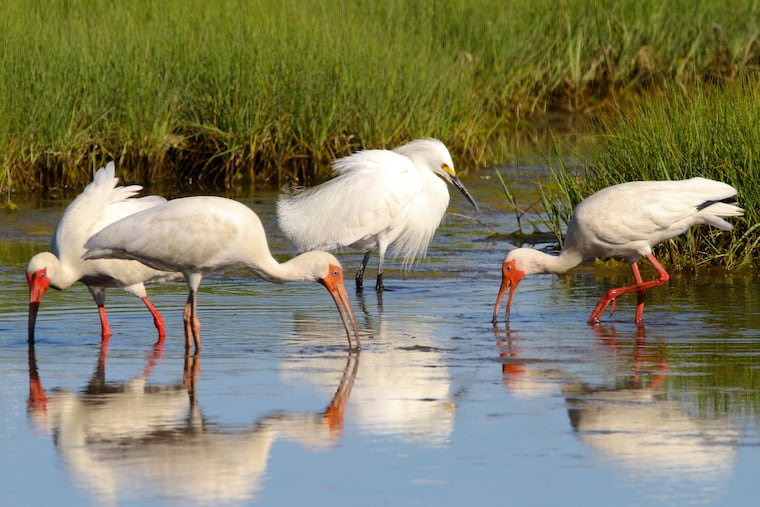Why has this exotic bird suddenly made its home at the Shore? Some think climate change.
The white ibis is now likely a permanent New Jersey resident numbering in the hundreds.

In 2019, birders spotted a dozen distinctive white ibises — marked by snowy bodies and bright orange bills and legs — at the rookery at the Ocean City Welcome Center.
The bird normally makes its home in Florida and the southeast, feeding in salt marsh shallows, probing the bottom with a sweep of its bill.
Seeing a few birds feeding out of their normal range isn’t that unusual, but what happened next was: The white ibis spread along the Shore and began nesting. Now, it’s likely a permanent New Jersey resident numbering in the hundreds, some believe, because of climate change.
“It’s really important to recognize what’s going on and try to understand why,” said Devin Griffiths, a birder and spokesperson for the Wetlands Institute in Stone Harbor. “Whenever you have an expansion like this, it doesn’t happen in a vacuum. If a bird is expanding into a new territory, the first question is why?”
Four nests were spotted in 2020, followed by up to 20 in 2021, raising at least 43 young birds.
“This year, it’s more than doubled,” said Griffiths, who wrote an article on the expansion for the Seven Mile Times, a Jersey Shore publication.
Now, it’s believed there are at least 350 of the birds in the salt marshes of New Jersey.
Griffiths said other species now common in the area settled after they expanded their range, such as cardinals and mockingbirds during the early and mid-20th century. Carolina wrens and glossy ibis followed, as did red-bellied woodpeckers.
But, he said, those migrations took decades. The white ibis has apparently expanded its territory into New Jersey within two or three years. A similar phenomenon occurred with the bird’s expansion into Virginia.
Griffith said it’s difficult to know why the bird is expanding here. Loss of habitat in Florida, for example, could be pushing the bird to look elsewhere. But the belief is that climate change is a driving factor. The bird’s habitat could be changing because of warming of the air and water in New Jersey.
“Birds are literally the canary in the coal mine,” Griffiths said. “It means there is something strange going on, and there are broader implications. At the end of the day, anything that affects them, eventually affects us. We are not insulated.”
According to the Audubon Guide to North American Birds, Florida’s population of the white ibis has been declining for decades. The bird’s range, meanwhile, has increased, spreading north up the Atlantic Coast. The guide lists southern Delaware as its northernmost range.
Griffith said that while birders might greet the birds with delight, they could eventually be to the detriment of other smaller native species by pushing them to fringe areas, or pushing them out altogether.
The white ibis typically feeds on crayfish, crabs, frogs, snakes, small fish, insects, and marine worms, many of which are in abundance along New Jersey’s coast.
The birds migrate, but their range had not been this far north. Now, they start appearing in New Jersey in mid- to late April and are building nests by early May. They mate by the end of May or early June, then lay eggs shortly after that. The chicks start hatching in early July. By October, they head back south.
Though the Audubon guides does not currently include New Jersey as within the current migratory range, its climate change modeling suggests it would arrive sooner or later.